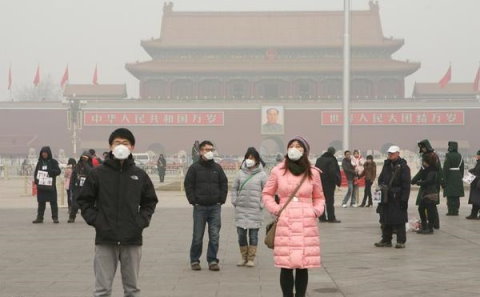GDP growth is still king in China
 0 Comment(s)
0 Comment(s) Print
Print E-mail China Dialogue, November 4, 2013
E-mail China Dialogue, November 4, 2013
China may finally have a new air pollution plan, but development is still the number one priority, says Li Junfeng, director of the National Centre for Climate Change Strategy and International Cooperation.
 |
|
Around 70% of China's energy comes from coal. [Photo/Greenpeace] |
Chinadialogue (CD): How strong would you say the air pollution plan is, as a national policy?
Li Junfeng: It can't be called weak, but it does need to be stronger, in three ways:
First, it doesn't recognise how serious the issue is. Ministry of Environmental Protection data shows that air quality is up to standard in less than 10% of Chinese cities, and things are particularly bad in the Beijing, Tianjin and Hebei area; and the Yangtze delta. This affects the people's health, and holds back investment. Second, it doesn't deal with the major problems – it goes into great depth on many specific measures, but still doesn't do enough to cut coal use or improve fuel quality.
Third, there's not enough confidence. China has plenty of experience of successful action at the national level, and we have the ability to add 50 billion natural gas, 20GW of hydropower, and 18GW of wind power in a year. Bringing smog under control will require improving the energy structure, and we need to be confident in our ability to do that.
CD: So there are conflicts between the plan's actual measures?
Li: On one hand it restricts coal consumption; on the other it encourages coal-to-gas production, further strengthening coal's position. Although it is explicit that coal-to-gas projects must implement "the strictest of environmental protection measures", that in itself demonstrates that there are environmental problems with coal-to-gas. Coal-to-gas emits more than twice as much carbon as natural gas. And once you choose an energy technology it then becomes locked in for decades, not just a few years.
CD: Is the coal-reliant energy sector the root cause of air pollution problems?
Li: Twenty years ago China consumed one billion tonnes of coal a year and that seemed too much. Now we get through four billion tonnes and we want to use more. If we don't do something now it'll be even harder in ten years – we'll be consuming more coal and be faced with more problems.
For years there's been a fixed way of thinking about this: "we've got to use coal, it's all we've got." Aside from China there are no more than ten countries where coal accounts for more than half of all energy. If China is excluded, then globally coal accounts for less than 20% of energy production – but here it's 70%. China accounts for half of global coal use, but this isn't inevitable. China and the US are of roughly the same size and consume roughly equal amounts of energy, and we have over 100 million less cars – yet the US has much better air quality.
There are only two relevant differences: the US has better quality fuel, and the US uses less coal. Our fuel standards allow for 100 times more sulphur in diesel as the equivalent rules in the US. And despite consuming roughly equal amounts of energy the US consumes 600 million tonnes of coal a year, compared to our 4,000 million tonnes, seven times as much.






Go to Forum >>0 Comment(s)